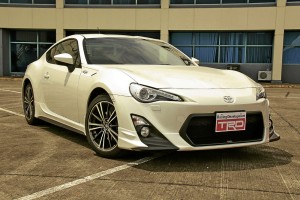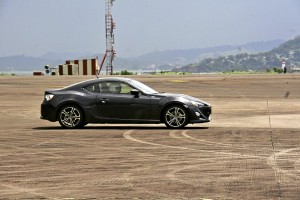
THE 86 was designed to bring back a back-to-basics rear-wheel drive car that is fun on the track and on twisting mountain roads not a drag racing rocket sledge.
While the rest of the country laments the fact that all 77 units of the Toyota FT 86 are now already sold, with a rumored 500 more or so waiting for the next batch of stocks to arrive over the coming years, and with grey-market Scion FR-S (the Toyota 86 is marketed as the Scion FR-S in the United States, Scion being a sub-brand of Toyota for the youth and young at heart) commanding a significant premium despite being under-spec’d relative to the 86’s we get, enthusiasts all over are going mad talking non-stop about the 86 and its tuning potential.
The 86 is truly a masterpiece. I’ve driven it quite extensively on public roads, on an airfield and in a make-shift gymkhana track, in both wet and dry conditions. So I firmly believe it is one of the greatest, regardless of the price. The 86 is pure, linear, engaging and honest. I literally run out of superlatives thinking about the 86’s repertoire of dynamic handling talents. But for once, let’s consider what the 86 is not.
First off, it’s not fast. Not even close. When Akio Toyoda, the big boss of Toyota and grandson of the founder commissioned the 86, he wanted to bring back a back-to-basics rear-wheel drive car that is fun on the track and on twisting mountain roads. He didn’t want a drag racing rocket sledge. More power brings with it a certain type of fun, but this isn’t what the 86 is for. Besides, you won’t miss the speed and power in the 86. Sure, professional drift teams have started to work on the 86 in Japan and have swapped the engine with a Lexus IS-F V8 (2UR-GSE) in Manabu Orido’s car, an older Toyota 2JZ-GTE inline six in another drift car, a 2.65-liter EJ STI Subaru block for Tetsuya Hibino made by Cosworth, and NOB Taniguchi’s own 86 that utilizes the stock engine but with prototype HKS supercharger and other parts. But these teams are professional and have done their homework, modifying the entire car (chassis, suspension) to suit the new powertrain. It’s not exactly a backyard mechanic effort. The 86 is so well balanced as it is, which is what makes it fun and really quick. Fast is measured as terminal velocity in a straight line, whereas quick is measured by time from two points.

IF YOU can live with the heft of the controls, it makes for a perfect everyday car as the engine is very fuel-efficient.
Secondly, while the tall ride height looks kind of awkward, it is there for a reason. The suspension has been so well-honed, so perfectly in terms of firmness and compliance, that messing with the suspension is like messing with the Mona Lisa. Lower it and you might lose compliance over the bumpy stuff (therefore slowing you down) or lose suspension travel on the track (which loses traction and can slow you down), which can upset its balance and, ultimately, its handling delicacy and outright performance. TRD in Japan has released a firmer, height-adjustable coil-over suspension system with bigger and wider tires, which foreign journalists have tested and found to be more track-biased, with more grip, less slip but also less on progression: Keen drivers want that progression while racers want that extra bit of grip. It will be made available here so that’s perhaps the safest way to modify the 86’s suspension. But understand that again: more grip can lose some progression, which is what makes the 86 so much fun to drive.
Thirdly, I admire show cars and their intense build, and that comes with usually lots of audio and sometimes heavy body kits. The 86 has a weight balance ratio of precisely 52:48, with the front getting a bit more weight bias. Adding heavy speakers and amplifiers at the trunk, or a heavy body kit all over can upset the car’s overall performance, not just because to the added weight but moving the weight around the car’s rear-end. Making the rear end heavy can also make the car lose balance. Which, again, diminishes the car’s progressive and linear nature. In a relative lightweight car (1275 kg for the manual), adding a little weight has a dramatic effect on the car’s feel and handling.
Fourth and last, the 86 isn’t for everyone. A friend and fellow enthusiast once told me that people will be swept away by the 86 hype. It is truly a good car, but I fear many people who will buy it will not appreciate its true value: that it is a car one can hone his or her talents with, both on the road and on the track. Many enthusiasts want instant gratification, something an Evo, STI or Nissan GTR will provide but the 86 will not, which will disappoint many. The clutch is heavy for a Toyota, but perfectly weighted. The steering is heavy for a Toyota too, but is brimming with feel. The long-travel throttle pedal response is immediate, perfect for heel-toe downshifts and double-declutching. In short, it’s not your typical Toyota. You really have to work the car to get the best out of it, and it will get you into trouble if you’re not careful. If you can live with the heft of the controls, it makes for a perfect everyday car as the engine is very fuel-efficient. Me? I’ll be waiting for a cheap second-hand 86 sometime in the near future.

